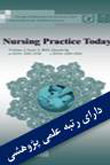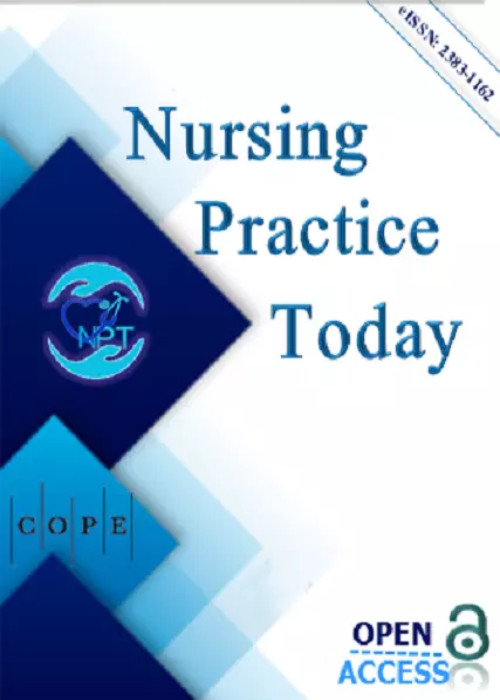فهرست مطالب

Nursing Practice Today
Volume:3 Issue: 3, Summer 2016
- تاریخ انتشار: 1395/05/20
- تعداد عناوین: 6
-
-
Pages 79-80
-
Pages 81-90Background and AimInfertility and its treatment are considered a crisis in womens life which would affect different aspects of their quality of life. Along with therapeutic measures, infertile women need educating and continuous care. This study was conducted to evaluate the effect of educating based on continuous care model on treatment-related quality of life in infertile women.
Methods & Materials: In this semi-experimental study, 80 infertile women who referred to selected infertility centers of Tehran University of Medical Sciences during 2015 were enrolled through convenient sampling. For the samples of the control and the intervention group would not encounter each other, two different centers were selected for sampling. Data were gathered through demographic-obstetrical characteristics questionnaire and the Fertility Quality of Life (Fertil QoL) tool. The control group received the routine cares of the infertility center. To conduct continuous care model for the intervention group, based on the needs of participants, 2 or 3 educational sessions (1 to 2 hours) were conducted within a period of 7 to 10 days in the form of speech and question and answer and then the booklets of the presented subjects were distributed among the participants. Quality of life of infertile women was evaluated in both groups at two stages, before and 2 months after the intervention. Data were analyzed using Chi square test, Fishers exact test, independent t test and Paired t test through SPSS 16. The level of significance was set at less than 0.05.ResultsBoth of the intervention and the control group were similar before the intervention regarding their demographic characteristics and the score of quality of life (p > 0.05). The scores of quality of life after the intervention were 25.28 ± 4.602 and 30.08 ± 2.474 for the intervention and the control group, respectively, which indicates the effect of educating based on continuous care model on the infertility-related quality of life.ConclusionsEducating based on continuous care model would improve therapy-related quality of life in infertile women and it is recommended that this model should be used as an easy, low-cost and convenient model in educational programs of midwifery.Keywords: continuous care model, therapy-related quality of life, infertility -
Pages 91-98Background and AimLack of adherence to prescribed medication is a main concern in medicine especially in chronic diseases. The aim of present study was to determine the effect of supportive text message on the adherence to treatment of depression.
Methods & Materials: This quasi-experimental study was conducted on sixty eligible patients with diagnosis of depression who referred to a psychiatry clinic in Shahrekord. The patients were allocated to supportive text message and control groups. The patients in both groups were treated with the same antidepressants; however, the patients in supportive text message group additionally received daily text messages for six weeks. The adherence to medication was assessed by a researcher-made questionnaire and the severity of depression was assessed by Beck depression inventory.ResultsImmediately after intervention, average score of depression showed a significant improvement in both groups (PConclusionDaily supportive text message in this study could not improve antidepressant adherence and depressive symptoms in patients with major depression.Keywords: depression, treatment refusal, text messaging, adherence, medication -
Pages 99-106Background and AimFacilitating peoples access to necessary health services is one of the most important strategies to reach social justice within countries health system. Therefore in-time access to health cares and ensuring desirable results are essential. This study was conducted to evaluate the perception of martyrs parents of accessing the services of health monitoring plan.Materials And MethodsThis descriptive-analytic (cross-sectional) study was conducted on 246 parents of martyrs under the supervision of Foundation of Martyrs and Veterans Affair of 10 and 11 districts of Tehran who used the services of health monitoring plan; samples were selected through simple randomized sampling. Data gathering tool was a researcher-made questionnaire that contained two parts of demographic characteristics with 18 items and perception of access with 20 items. Data were analyzed using SPSS 16, descriptive statistics, Fishers test and Chi-square test.ResultsResults showed that 92.3% of the parents had a medium perception of access to the services of health monitoring plan. Also evaluating different dimensions of access showed that the perception of martyrs parents in the dimensions of accessibility and affordability was poor and were respectively 75.2% and 73.2%.ConclusionsIt is necessary to improve the accessibility and affordability dimensions of access among martyrs parents.Keywords: availability, accessibility, affordability, acceptability, accommodation
-
Pages 107-115Background and AimFor diagnosis, prevention and treatment of female sexual problems, it is crucial to understand the ways women conceptualize their sexuality. The aim of current qualitative study was to explore the participants perceptions and understanding of sexuality.
Methods & Materials: In this qualitative study, fifteen married women aged 21-42 interviewed face to face as they referred to the selected outpatient clinics to receive care and treatment for their sexual problems. The kind of their sexual problems has been confirmed through interview, Brief Index of Sexual Function-Women (BISF-W) and Female Sexual Distress- Revised (FSD-R) questionnaire before conducting in-depth semi-structured interviews.ResultsThe obtained theme from content analysis indicated that women conceptualize sexuality as any interaction between man and woman that leads to pleasure and tranquility. This main theme comprises two categories that include emotional intimacy and sexual intimacy. All the women claimed that emotional intimacy behaviors were the most and the majority of them believed that coital behaviors were the least enjoyable aspects of their sexuality. Women rarely refer to spontaneous sexual desire or fantasy and they believed that pleasure was more important than orgasm in their sexual life. Participants didnt mention to oral and anal sex, and self-stimulation in their statements.ConclusionThe findings of this research are support previous studies that showed for women emotional closeness is the main aspect of sexuality and it is the prerequisite to a fulfilling sex life. In the other hands, this study show that womens description of sexual norms is different in some aspects from that in women of western context, therefore clinicians should consider participants definitions and pay attention to the socio-cultural aspects of sexuality.Keywords: women's health, qualitative study, sexuality, sexual behavior, Iran -
Pages 116-123Background and AimQuality of life refers to satisfaction or dissatisfaction with various important life domains. Sleep disorder is one of the factors which can influence the quality of life. This study has been conducted in order to investigate the relation between quality of life and sleep quality in the Kurdish elderly of Saqqez County.
Methods & Materials: This correlational study was conducted in 2016 on 292 elderly people in Saqqez County. Data were gathered using, the SF-36 questionnaire and the Pittsburgh Sleep Quality Index. Data analysis was performed by SPSS version 18 and descriptive statistics tests, KolmogorovSmirnov test, Spearman's correlation coefficient and MannWhitney U test. The statistical significance level was determined as less than 0.05.ResultsThe average quality of life score and elderly sleep quality were 48.39± 16 and 11±3.6, respectively. Quality of life had a significant correlation with all domains of sleep quality. The educated elderly had higher life and sleep qualities compared to the illiterate ones. Quality of life in men was higher than that of women, but there was no significant difference between them in case of sleep quality.ConclusionBy enhancing the sleep quality, the quality of life will also be improved. Sleep hygiene education seems to be necessary for improving the quality of life in the elderly.Keywords: quality of Life, sleep Quality, elderly


